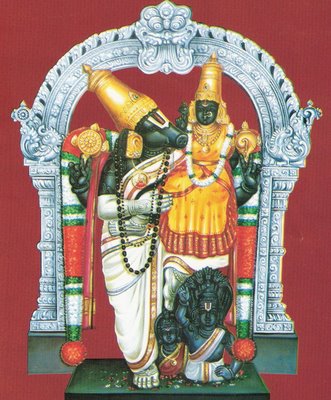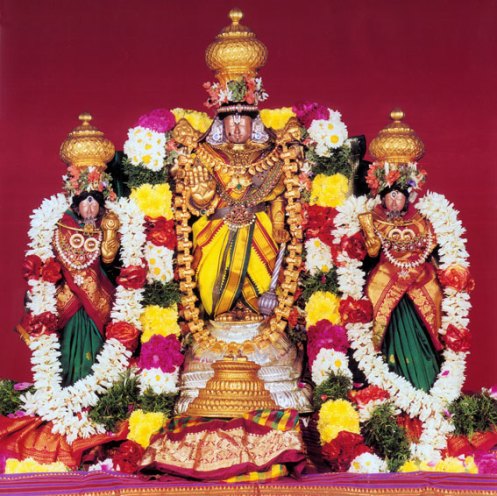







The Lord is in standing pose at the foot of the hill. When we go up the hill, we can see the remaining Three poses of the Lord. At the bottom of the hill is Sri Neervannan. He shows simplicity. He is very simple to reach. He is also of dark blue color, like water. Here, Valmiki, who wrote Srimad Ramayanam, is gracing. Valmiki climbed up the hill and worshiped the Lord in all Three sannidhis. He worshiped Sri Narasimha in sitting pose, Sri Ranganatha in reclining pose and Sri Trivikrama in walking pose. With all that, he did not get the satisfaction of worshiping Sri Rama. Therefore, Sri Rama Himself is gracing to satisfy Valmiki.
62.TIRUVIDANDAI திருவிடந்தை:





The Lord appeared as Sri Varaha for a sage. Here, Sri Thayar is seated on His left lap and the Lord is gracing as Sri Lakshmi Varaha. A rishi had a daughter, for whom he was searching suitable bridegroom. She was married to sage Kalava and they had 360 daughters! When the parents were worried as to how to get all of them married, the Lord Himself offered to marry all, each one day, through out the year! On the last day, He appeared as Sri Varaha. Sri Utsavar is Sri Nitya Kalyana Perumal. It is believed that those desiring to get married, offer garlands to the Lord and later, wearing those garlands, they go round the temple and their marriages are settled.
63. TIRU KADALMALLAI [MAHABALIPURAM] திருக் கடல்மல்லை [மகாபலிபுரம்] :




Place is popular as Mahabalipuram or Mamallapuram. In Sanga age, it was known as Tiru Kadalmallai. The Lord instead of reclining on the Snake bed in the ocean, preferred to lie down on ground and so is called Sri Sthala Sayana Perumal. Sri Thayar is Sri Nilamangai Thayar. There was a sage Pundareeka, desiring to offer plenty of flowers and worship the Lord. He had heard that the Lord was reclining in the middle of ocean. With deep devotion blanking any practical thought, he thought he would throw out the water in the ocean, so that he could go and approach the Lord, to perform pooja. He started collecting ocean water and throwing at another place. Unmindful of the impossible, he was dedicated in his work and the flowers kept in basket nearby, were remaining afresh! When another sage approached him for food, this sage asked the guest to look after and rushed to bring food. Appreciating the intense devotion, the Lord came out of the ocean and laid Himself on ground to accept all the flowers. The Second Alwar among Alwars, Boothathalwar, was born here. Behind this temple, the Lord appears as Sri Valavendai Perumal [ஸ்ரீ வலவெந்தை பெருமாள்]. We saw Sri Idavendai Perumal earlier ;and, here, Sri Thayar is on His right lap!
64. TIRU KADIGAI [CHOLA SIMHA PURAM, SHOLINGAR] திருக் கடிகை [சோழசிம்தபுரம், சோளிங்கர்]:








The Lord is Sri Bhaktochita, Sri Akkarakkani and Sri Thakkan. Sri Moolavar is Sri Yoga Narasimha Swamy. There are Two hills - Big and Small. Seven sages wanted to see the Lord and meditated. 'Ghatika' is a small time measure. If we meditate on the Lord even for a ghatika, the Lord would bless us. The Lord is gracing with Sri Amrutavalli Thayar. The Lord deputed Hanuman to protect the meditating sages. Hanuman is gracing in Chinna [small] malai [hill]. To protect the sages, the Lord had given him, His conch and discus. Pushkarini is large and is called Thakkan Kulam [தக்கான் குளம்]. Swami Doddayacharya lived here. With this, we conclude visit to Tondai Naadu Kshetrams. We will now proceed to visit Malayala Divya desams.
65. TIRU NAAVAI திரு நாவாய்:


The Lord here is Sri Mukundan. This place is called Navayogi sthalam, and Nine yogis had meditated here. Navayogi has got mutilated to Naavai. Also Naavai means boat and the Lord acts as boat, for us to cross samsaram. Only in this Kshetram [in Malai Naadu], there is separate sannidhi for Sri Thayar. Kshetram is on the banks of Bharata puzha river.
66. TIRU VITHUVAKODU திரு வித்துவக்கோடு:

The Lord presented Himself here to Sri Lakshmi and Gajendra. The Lord here was established by Pandavas. Four idols of the Lord are in one temple. Kulasekara Alwar has praised the Lord.
Now we will see sloka 61:
īśvaraḥ sarvabhūtānāṃ hṛddeśerjuna tiṣṭhati
bhrāmayan sarvabhūtāni yantrārūḍhāni māyayā 18.61
This sloka is a reply to Arjuna's doubt that what if he neglected the Lord's advice and did not fight. But it was Arjuna's nature to fight, the Lord had replied, in the last sloka. Arjuna wanted to know whether he was acting dictated by the Lord, or on his own. If Arjuna was acting on his own, then the Lord had no control over Arjuna; on the contrary, if Arjuna was doing at the behest of the Lord, then it was better that the Lord Himself did whatever He wanted. Or, under His control was Arjuna doing? This is being clarified by the Lord. Sarvabhutanam = for every living beings, isvara = Leader with commanding powers, hrddes = in their heart [from where Gyana originates], tishtati = is present. The Lord is present at the very root of the place, from where knowledge originates. Yantra = on prakruti or body, arudhani = placed, bhramayam = well entangled. Body is commanded by atman, which is controlled by the Lord. Maya = prakruti with the three qualities. The body has the three qualities and atman is in the body according to past karma, and the Lord is controlling the atman. He is not controlling indiscriminately but according to papa/punya. Thus what we do accumulates as papa/punya, and the Lord controls each of us according to our nature.
No comments:
Post a Comment